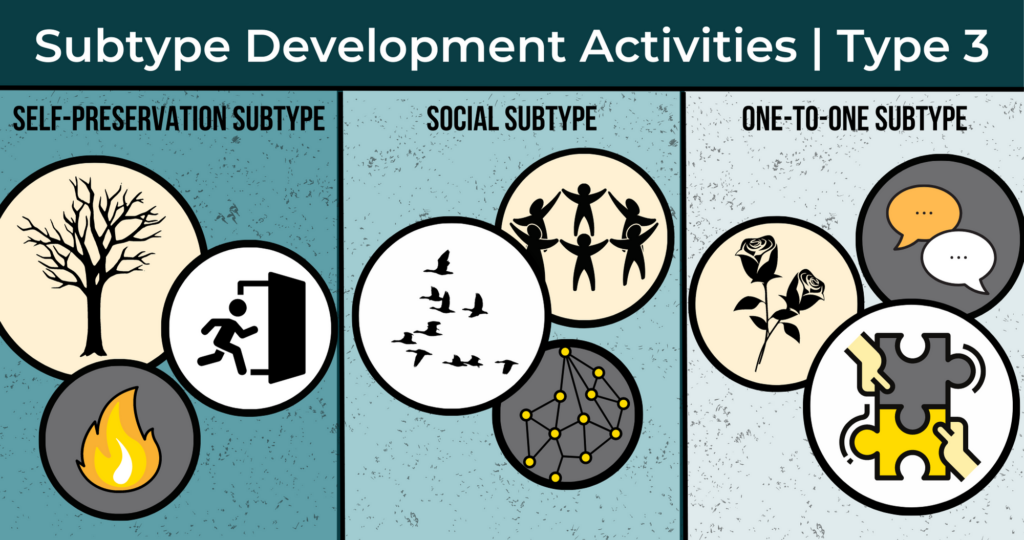There are three versions of each Enneagram type called subtypes: self-preserving subtype, social subtype and one-to-one subtype. Subtypes are formed when the emotional patterns or habits of our type, also called the type’s passion or vice, intersect and combine with one of the three basic human instincts, the instinct that is most activated within us: self-preservation instinct, social instinct or one-to-one instinct. We may have more than one activated instinct, so we could relate to two or even all three subtypes for our type.
Each instinct has specific focal areas. Individuals with that activated instinct, once it combines with the emotional pattern of our type, may move toward that instinctual area, away from that arena, or have ambivalence about that area. A way of understanding this is that the instincts by themselves are simply human and natural. However, when the activated instinct(s) combines with our type-based emotional pattern, the instinct then becomes distorted and, thus, less able to satisfy our natural needs in that instinctual area.
Here you can read about the passion or emotional habit of the type, a name for and a description of that subtype as it combines the emotional habit with that instinct, followed by one specific development idea that is particularly useful to people of that subtype. Please remember that we may have more than one active subtype, so the development activities for the additional subtype are also good for your development.
THREES
Emotional pattern of DECEIT
Needing to appear successful to gain the admiration and respect of others and avoiding failure by hiding parts of yourself and believing that your image is your true self
Self-preservation Three subtypes
Self-Preservation Three subtypes (“security”) want to be seen as a good or ideal person who is self-reliant, autonomous, hardworking, and have an image of having no image and being authentic.
Self-preservation Three subtype development
Notice how you move fast, like to create structure as a way to feel more certain or secure, and allow yourself little time for your feelings and desires to emerge; find deeper connection with yourself and others.
One way to find deeper connection with yourself and others:
Ask yourself the following question at least once a day: Am I sharing more of a deeper and real self with others rather than only engaging in activities with them?
Social Three subtypes
Social Three subtypes (“prestige”) want to be seen as successful and admirable in the context of specific social groups and like being around other successful people because they believe this proximity reinforces their own positive image and status.
Social Three subtype development
Notice how you like to impress others and also emulate successful people; reveal more of your true self and follow what you really want, not what you think you should want because it confers social status.
One way to reveal more of your true self and follow what you really want, not what you think you should want because it confers social status:
Notice when you try to fit in with prestigious social groups and what you have to do (and have to give up) to be accepted.
One-to-One Three subtypes
One-to-One Three subtypes (“masculinity/femininity”) try to draw important individuals to them by appearing highly attractive and successful and also make great efforts to help these others achieve success as if these accomplishments reflect positively on their own importance.
One-to-One Three subtype development
Notice how you live for and through your partners by appealing to and supporting them; learn to support yourself better.
One way to support yourself better:
When you offer various kinds of support to others in your life such as time, encouragement, resources and more, stop and ask yourself: Why am I doing this? What would happen if I gave that kind of support to myself? Are these the people I really want in my life? Do they support my inner sense of being and self-acceptance or do I want them in my life to affirm something about myself?
These activities are excerpts from the new additions to the soon-available 3rd edition of The Enneagram Development Guide, with over 60 development activities for each Enneagram type.
Ginger Lapid-Bogda PhD, author of nine Enneagram books, is a speaker, consultant, trainer, and coach. She provides certification programs and training tools for business professionals around the world who want to bring the Enneagram into organizations with high-impact business applications. TheEnneagramInBusiness.com | ginger@theenneagraminbusiness.com


Comments are closed.